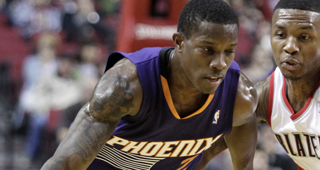When Eric Bledsoe tweeted “I don’t want to be here anymore” shortly after the Phoenix Suns fired head coach Earl Watson, he almost certainly accelerated his inevitable trade. While many teams received speculatory discussions, the Milwaukee Bucks kept coming up as a logical fit. In the rare case where theory matched reality, Bledsoe was indeed dealt to Milwaukee.
The Bucks traded Greg Monroe, a protected 2018 first round pick and a protected 2018 second round pick to the Suns for Bledsoe. Despite the presence of reigning Rookie of the Year Malcolm Brogdon, it is expected that Bledsoe will eventually take over as Milwaukee’s starting point guard. For a team that is firmly in the middle of the Eastern Conference playoff picture, this deal may elevate the Bucks to the top half of the conference.
Bledsoe stayed healthy last season and had career best production, averaging over 21 points per game and 6.3 assists in 66 games played. Phoenix shut him down late in the year as they had nothing to play for and didn’t want him to finish the season hurt. Bledsoe also played solid defense on a team that wasn’t exactly filled with good defenders. Overall, between the combination of health and production, Bledsoe was finally the player the Suns hoped he would be when they signed him to a five-year, $70 million deal.
Unfortunately, it wasn’t meant to be. With the team off to a terrible start, Phoenix fired Watson and, after years of trade rumors, Bledsoe finally made it known he wanted a fresh start. The Bucks were all too happy to oblige and did so at relatively low cost.
Monroe has been out recently with a calf injury and during that time Milwaukee hasn’t really missed a beat. They moved John Henson into the starting lineup and have been bringing Thon Maker off the bench in Monroe’s center/forward role. Mirza Teletovic has the reserve stretch big role locked down, leaving some to question what Monroe’s role might have been going forward. In addition, when Jabari Parker returns from his second torn ACL, the rotation would have crowded even further. The Bucks have now cleared up a logjam in the big rotation and have upgraded at point guard as well.
Bledsoe will bring Milwaukee more athleticism at the position than they currently have with Brogdon and backup Matthew Dellavedova. Once he takes over the starting role, the Bucks will have a running mate that can come close to matching Giannis Antetokounmpo as an athlete. Bledsoe is good at getting up and down the floor, but might at his best attacking the paint in the halfcourt.
While Brogdon is good already and continuing to improve, he’s not the best creator off the bounce. Milwaukee has good shooters on the perimeter in Khris Middleton and Tony Snell, but things all too often fall to Antetokounmpo to create all the offense. With Bledsoe’s ability to get into the paint and find shooters and cutters, it should help open up the offense significantly for the rest of the Bucks.
Because of Bledsoe’s strength, as well as the size of Brogdon and Dellavedova, you can easily see them playing together in the backcourt. This will not only further help open up the offense, but also helps solve for the lack of a consistent backup shooting guard. Milwaukee has tried Rashad Vaughn, Jason Terry and DeAndre Liggins over the last two seasons, but none have seized the role. Jason Kidd can now turn to a dual point guard look off the bench and is likely to do so on a regular basis.
Giving up Monroe wasn’t costly, despite him still being a productive player, and the picks they traded don’t seem all that exorbitant either. The 2018 first only goes to the Suns if it falls between 11 and 16. This protects Milwaukee if they are a high lottery team, as well as allowing them to keep the pick if they are solidly in the playoffs this year. The protections then drop to 1-3 and 17-30 in 2019, before loosening to just 1-7 in 2020, finally becoming unprotected in 2021. The second round pick is protected for the top half of the round, as Phoenix will only get the pick if it falls between 48 and 60. If it lands between 31 and 47, the obligation is extinguished and the Suns get no second rounder.
The Bucks did solid work by protecting themselves in case the bottom falls out, or in case they are a top tier playoff team. All too often, teams protect only one side or the other and then lose an asset they would rather have kept. And putting such stringent protections on the second rounder really puts Milwaukee in good shape if everything falls apart on them.
Overall, the Bucks did great in this deal. They dealt from a position of strength to improve a position of weakness, protected their picks in a smart way, and got a good player who is under contract for an additional year beyond this one. Milwaukee also created a Traded Player Exception of $3.3 million, which could prove useful in acquiring another piece for the playoff run.
Grade for the Bucks: A
When a player makes it clear he wants out, the incumbent team is put in a very difficult situation. If they keep the player, they run the risk of that player infecting the entire squad with a likely poor attitude. Trading the player is the logical move, but by making his desire to be traded known, the team has lost some leverage. When the team sends the player home, as the Suns did with Bledsoe, that leverage is only further lessened.
That said, Phoenix did okay here with their return. To be completely clear, Monroe has no on court value for the Suns. He’s probably better than any other big they currently have on the roster, but that is in the present day. Phoenix isn’t playing for the present, but for the future. Thus, they are better served to play their young players. Monroe actually has more value to Phoenix as a player they can flip in a subsequent trade to gain another asset, than he’ll ever have in a Suns uniform.
When you are a bad team, which the Suns are (recent run notwithstanding), the goal is to acquire talent and assets. Ideally the talent is young and can grow together, which Phoenix has plenty of. Any players who are on the roster that don’t fit the timeline should be viable candidates for trades. This is squarely where Bledsoe fell for the Suns. He’s a little too old to fit with the up and coming young players, but not so experienced that he’s a veteran mentor type, like Tyson Chandler or Jared Dudley. Combine that with his injury history, and stated desire to be elsewhere, and a trade was a no-brainer.
That Phoenix was able to add a future first round pick, and a possible second round pick, is making lemonade from lemons. Even if the pick doesn’t convey this year, the sliding protections make it that much more valuable for the Suns. Every year they don’t get it is another year closer to Milwaukee maxing out around Giannis and it all falling apart for the Bucks. Even if the Suns do get the pick this year, they add another mid-first rounder to a stash that is likely to include their own first (probably a high lottery pick) and a first round pick from the Miami Heat. Having flexibility to move up and down the draft board because you have extra picks is something that Phoenix used previously to draft Marquese Chriss. The early returns on positive on that one for the Suns.
Unfortunately for Phoenix, they are fairly well stocked with youthful talent at every position but the one Bledsoe is vacating. They have Chriss, Dragan Bender, Alex Len and Alan Williams up front and Devin Booker, T.J. Warren and Josh Jackson on the wing. That is the start of something. But that group lacks a floor general to lead them. Tyler Ulis is a nice enough player, but he projects to be a career backup. The Suns have actually been starting two-way player Mike James since they benched Bledsoe, but he’s spent his entire career overseas to this point. He’s not really the long term answer at the point for the franchise.
With some increased cap flexibility by shedding Bledsoe’s second year of his deal, and plenty of draft picks, expect Phoenix to target a point guard, either in trade or free agency. While the free agent class isn’t exactly awash in high end talent, the Suns could potentially maneuver to enough cap space to make a play for one of the better restricted free agents on the market. That group includes Marcus Smart, Elfrid Payton and Dante Exum. All three of those players come from incumbent teams that have some level of salary and luxury tax concerns that a big offer sheet could scare them off. More importantly, all three players would fit in quite well with the rest of the Suns young roster.
One final thing this trade likely locks in is that James will probably be the first player to have his two-way contract converted to a standard NBA deal. Two-way players are limited to 45 days with the NBA club once the NBAGL season kicks off. With the NBAGL season now well under way, James is eating up days towards that 45 day clock rather quickly. It is important to note that it is 45 days and not 45 games that counts towards the clock. Practices, games and even off days, all figure into the calculation. Considering James is the Suns starting point guard, and now just one of two true lead guards on the roster, Phoenix is likely to convert him sooner, rather than later. The Suns will have to clear a roster spot to do so, but could easily make that happen with another trade or by waiving a back end roster player like Derrick Jones Jr.
While it is somewhat sad that the surprising, fun group from 2014 never made a playoff appearance and broke up rather quickly, it was somewhat inevitable. Jeff Hornacek played an innovative style that featured dual point guard with Bledsoe and Dragic, but point guards are the NBA’s last lone wolf position. Much like quarterbacks in the NFL, if you have two, you might really have none. And that is exactly where the Suns find themselves after this trade.
Grade for the Suns: C+



